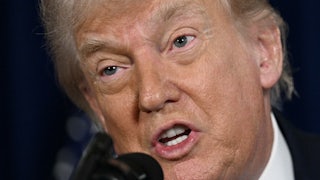On Friday, amid mounting pressure to do something—anything, really—to respond in some material way to the threats to reproductive rights spurred by the Supreme Court’s decision to overturn Roe v. Wade last month, President Joe Biden signed an executive action relating to contraceptive access and interstate travel. The president’s orders effectively act as bulwarks against potential laws that are likely to be passed in some states controlled by Republicans: One was aimed at efforts to restrict access to federally approved abortion medication, the second responded to the threat of Republican attempts to make traveling across state lines to receive an abortion illegal. Still, the most notable thing about these executive orders was that they were so late in arriving.
Samuel Alito’s draft decision overturning Roe leaked on May 3; it was widely known that when the decision became official, numerous “trigger laws” further limiting reproductive rights would snap into place all across the country and that Republican legislatures would get to work—on not just the next wave of abortion restrictions but the next fronts in the culture war. The White House—and, for that matter, senior Democratic leadership—has had two months to prepare for events that became inevitable the moment Amy Coney Barrett was confirmed to the Supreme Court in the fall of 2020. Charitably, the response from Biden and other senior White House figures has been passive at best. When they have said anything, it has been “vote”—a word Biden repeated several times in a row while signing the actions on Friday, seemingly without regard for the GOP’s well-funded voter-suppression campaign for which the administration has provided few countermeasures. Nevertheless, these admonitions were vastly superior to the word salad Kamala Harris offered during a Sunday appearance on Face the Nation.
VP Kamala Harris admits that the right to an abortion was taken for “granted,” but says Congress must now codify the “principles behind Roe,” similarly to what America did with the Voting Rights Act and the Civil Rights Act. pic.twitter.com/xI6XtetxAm
— Face The Nation (@FaceTheNation) July 10, 2022
In a year of crises—Roe, Ukraine, inflation—Biden has been notably tucked away, his major communications coming in newspaper op-eds (another, Monday morning, detailed his goals for a diplomatic trip to the Middle East). With Roe, the situation is particularly galling, given the long lead time the administration was given. That Pete Buttigieg, the secretary of transportation, has recently emerged as the administration’s most effective spokesperson on a range of issues, is itself a damning indictment of the administration’s messaging. (Fox News keeps booking Buttigieg for appearances seemingly out of the desire to spar with someone with a pulse.)
On Friday, Bloomberg reported that the administration had considered declaring a public health emergency to protect abortion access but ultimately decided against it. It was more decisive on other matters: On the very same day that Roe was struck down, Biden reached a deal with Mitch McConnell to appoint an anti-abortion judge to the federal bench in Kentucky. When pressed about the administration’s lack of action regarding Roe, White House communications director Kate Bedingfield insisted that it was those who’d raised a hue and cry about the loss of reproductive freedom who were the real problem. “Joe Biden’s goal in responding to Dobbs is not to satisfy some activists who have been consistently out of step with the mainstream of the Democratic Party,” Bedingfield told The Washington Post. “It’s to deliver help to women who are in danger and assemble a broad-based coalition to defend a woman’s right to choose now, just as he assembled such a coalition to win during the 2020 campaign.” The message is clear: It’s your fault that we aren’t doing anything.
Biden’s absence is particularly striking because it’s so uncommon. “At least since Franklin Roosevelt, every president has in one way or another steered the national discussion or at minimum had a strong and impossible-to-miss voice in it,” wrote Robert Kuttner in The American Prospect over the weekend. “You almost have to go back to those mid-19th-century presidential nobodies—Franklin Pierce? Millard Fillmore?—to find a president who figured so little in the national discourse, or who so ceded leadership to prominent members of Congress.”
Biden appears to be trapped in a vicious cycle. With his approval rating plummeting, he and his advisers appear to be gripped with anxiety that doing anything will only make things worse. And so he says little and does nothing, hoping that voters will blame Republicans for what’s ailing the country—or at least recognize the existential threat they pose to American democracy—and vote for Democrats in November. It clearly isn’t working: In the most recent New York Times/Siena College poll, released on Monday, nearly two-thirds of Democratic voters say “they would prefer a new standard-bearer in the 2024 presidential campaign.”
What’s odd is that with Roe, the administration considered an option that would have helped its larger problems. Declaring a public health emergency would have led to a lengthy court battle. This is one reason why it was rejected out of hand. But right now, everything Democrats want to do will be subject to judicial review. Sometimes you need to pick the fights; in this case, it would have signaled an unfaltering commitment to battling for reproductive rights. Instead, Biden has essentially signaled that the fight cannot be enjoined until voters go to the polls in November. Voters, of course, understand the reality of congressional majorities. At the moment, however, they’re receiving little reason to be optimistic. Much of Biden’s current polling slide can be explained by diminished support among Democrats: More aggressive action—even more aggressive statements—could help stem the tide by providing a jolt of enthusiasm.
Doing something at this point is a tall order for an administration that seems intent on doing as little as possible to rock the boat. But for most of this year, as Biden has shrunk from the presidency, the enthusiasm for his presidency among ardent Democrats has waned. To achieve their electoral goals, Democrats need to give voters reasons to believe, and the only way to reverse Biden’s sliding popularity is for him to step forward and start providing these reasons.
The bully pulpit is not perfect. It is notoriously ineffective at persuading the masses to adopt policies that are broadly unpopular. But a large canon of political science research has found that it is effective at “facilitating change in a favorable environment”—that is, galvanizing the public behind popular ideas and breaking through the typical inertia of our politics. Abortion rights are very popular. This is very favorable terrain. It’s very reminiscent of a moment in May 2012 when a vice president went on television and said, of marriage equality, “The good news is that more and more Americans have come to understand that what this is all about is a simple proposition. Who do you love?” And the world spun forward.










